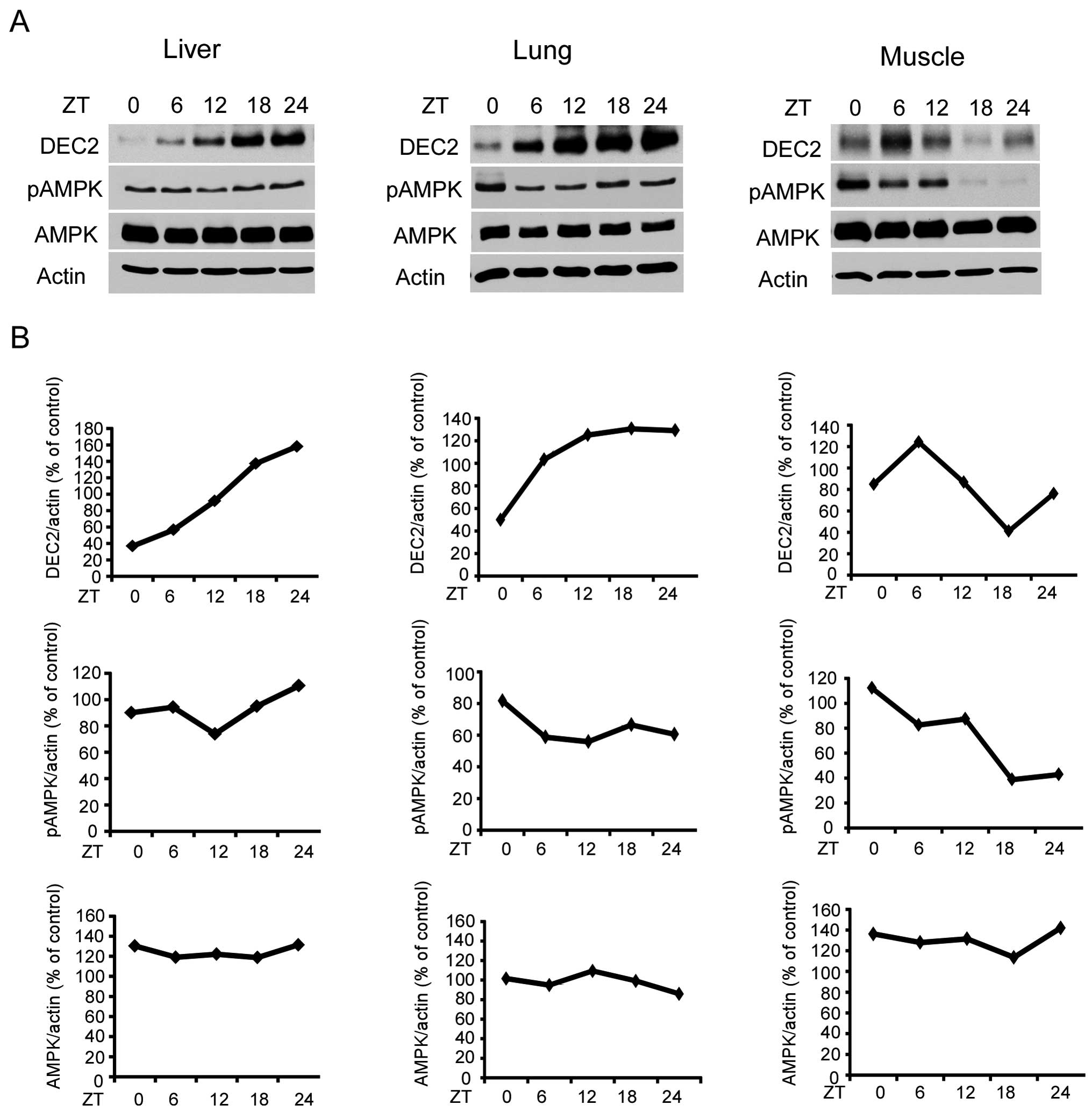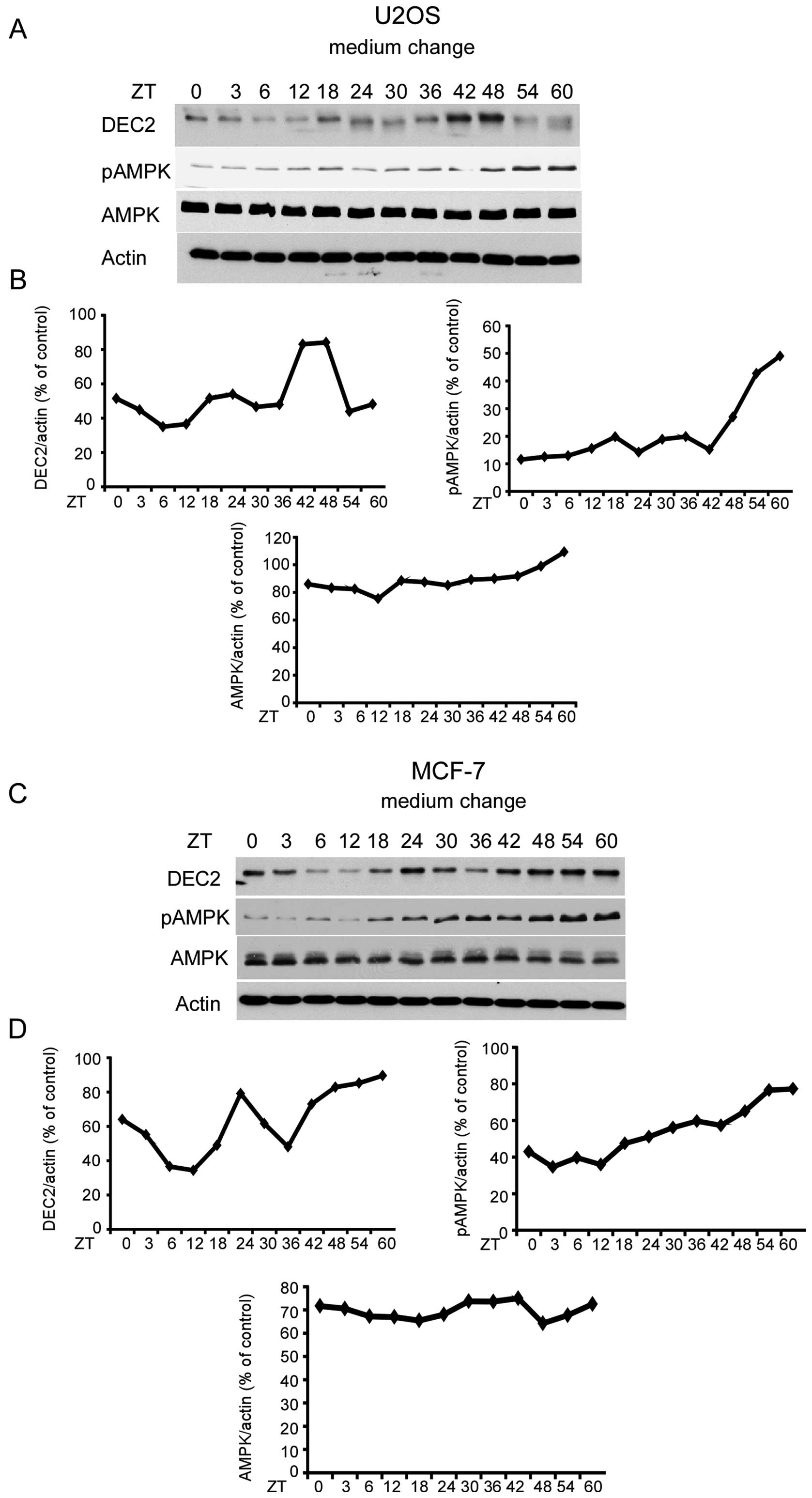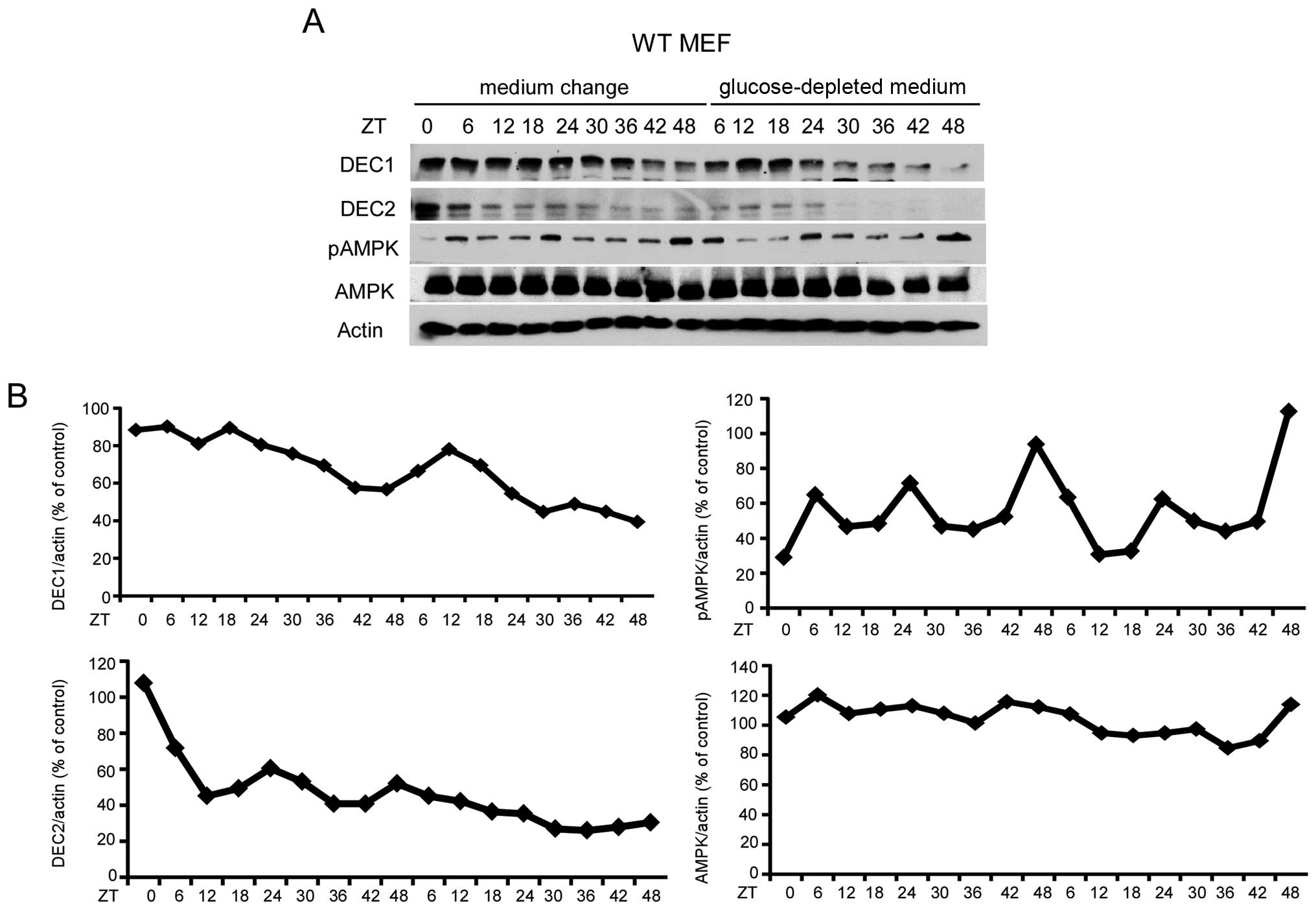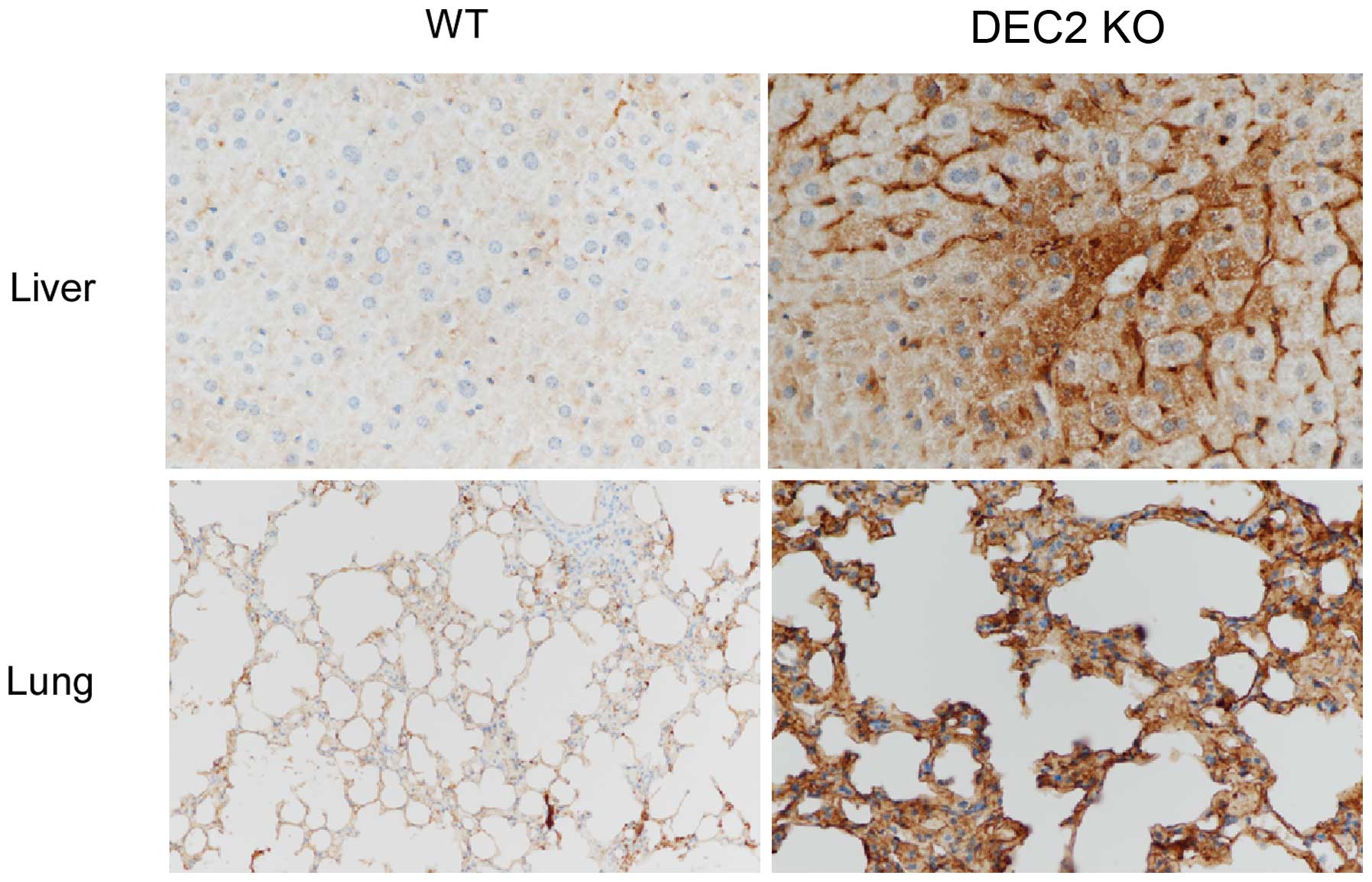Introduction
Circadian rhythms are important for living mammals
and are predominantly regulated by clock genes (1–3). Disturbance
of circadian rhythms may be associated with sleep disorder,
depression, diabetes and cancer (4–9). A growing
number of studies have shown that the abnormalities of clock gene
expression are associated with psychiatric disorders, tumor
progression, myocardial infarction, metabolic syndrome and immune
disorder (10–16).
The transcription factor DEC2 is important in the
circadian rhythm, hypoxia response, differentiation and tumor
progression (3,10,11,17–24). While
DEC1 and DEC2 mRNA indicate a rhythmic expression in the
suprachiasmatic nucleus (SCN), peripheral tissues, tumor cells and
human mesenchymal stem cells (MSCs) (3,17,18,21,25–29), whether
DEC2 protein has rhythmic expression remains unclear. It seems
likely that the rhythmic patterns of DEC1 and DEC2 are different in
cell types (26), and what influences
of DEC2 rhythmic expression under cell culture is poorly
understood.
AMP-activated protein kinase (AMPK) is a sensor of
cellular energy status (30,31). AMPK activity (phosphorylation of AMPK
or pAMPK) is important in glucose metabolism, cell death and tumor
progression (32,33). Rhythmic AMPK activity was observed in
mice and mouse embryonic fibroblasts (MEFs) and a loss of AMPK
disturbed the rhythmic expression of clock genes Bmal1 and
Per2 (34,35). DEC1 protein and AMPK activity are known
to have rhythmic expression in mouse liver, and DEC1 negatively
regulates AMPK activity (36).
However, the association between DEC2 and AMPK activity is
unclear.
In the present study, we investigated the rhythmic
expression of DEC2 protein and AMPK activity in mouse liver, lung
and muscle, MCF-7 and U2OS human cancer cell lines, and MEF. These
results may contribute to understanding of the biological functions
of DEC2 and AMPK activity in various cell types.
Materials and methods
Animals
Six to 8-week-old male C57BL/6 mice were housed as
previously described (26). The light
in the mouse room was turned on at 7:00 a.m. (ZT 0 corresponds to
7:00 a.m., lights turned on) and turned off at 7:00 p.m. (ZT 12).
Mice were entrained on a 12-h light/dark cycle for 2 weeks prior to
experiments. Tissue samples were extracted from the liver, lungs
and muscles of mice and were subjected to western blot analysis.
Animal care and use procedures were approved by the Institutional
Animal Care and Use Committee at the UNC at Chapel Hill Animal Care
Facility.
DEC2 knockout mice
DEC2−/− mice were generated by
inGenious Targeting Laboratory, Inc. (Stony Brook, NY, USA).
Briefly, the 2.8-kb BsiEI-AlwNI genomic region of DEC2 that
spans exons 1–5, including the entire coding region, was replaced
with a Neo cassette. The knockout mice were backcrossed onto a
C57BL/6 background. Six to 8-week-old mice were housed as above,
and tissues were prepared for immunohistochemistry.
Immunohistochemistry
pAMPK immunoreactivity in mouse liver and lung
tissues were evaluated using serial deparaffinized sections.
Immunohistochemistry was performed using a Discovery auto-stainer
machine with automated protocols (Ventana Medical Systems, Inc.,
Tucson, AZ, USA; Roche, Mannheim, Germany). Sections were reacted
with pAMPK antibody (1:100) for 2 h.
Cell culture and treatment
The MCF-7 human breast cancer and U2OS human
osteosarcoma cell lines were obtained from the American Type
Culture Collection (ATCC; Manassas, VA, USA). Primary MEF were
prepared as previously described (37). The cells were cultured in Dulbecco's
modified Eagle's medium (DMEM) (Sigma Chemical Co., St. Louis, MO,
USA) or in DMEM without glucose (Gibco-Life Technologies, Grand
Island, NY, USA) supplemented with 10% fetal bovine serum at 37°C
in a humidified atmosphere of 95% air and 5% CO2. The
medium change (fresh medium) was performed at 0 h, and the cells
were cultured for 48 or 60 h without further medium change.
Antibodies
The following commercial antibodies were purchased:
actin (mouse monoclonal, Ab-1; Millipore Corp., Billerica, MA,
USA), DEC1 (rabbit polyclonal, NB100-1800; Novus Biologicals,
Littleton, CO, USA), DEC2 (mouse monoclonal, E-4; Santa Cruz
Biotechnology Inc., Santa Cruz, CA, USA), pAMPK (rabbit monoclonal,
40H9) and AMPK (rabbit monoclonal, 23A3) (both from Cell Signaling
Technology, Inc., Danvers, MA, USA).
Western blotting
The cells treated with a medium change, or
glucose-depleted medium were lysed using 0.5% NP-40 lysis buffer
for western blot analysis. The total cell lysates were run on 12.5%
SDS-polyacrylamide gel followed by western blotting using the
standard procedure. The WesternBright ECL and WesternBright Sirius
kits (BioExpress, Kaysville, UT, USA) were used for antibody
detection.
Data quantification
The intensities of the bands detected in Western
blotting were quantified using Java based free software ImageJ
(NIH, Bethesda, MD, USA).
Results
Rhythmic expression of DEC2 protein
and pAMPK in mouse liver, lung and muscle
To investigate whether DEC2 protein and pAMPK showed
a rhythmic expression in vivo, we performed western blot
analysis using samples prepared from mouse liver, lungs and muscles
at indicated ZTs. The levels of DEC2 protein and pAMPK showed a
rhythmic expression (Fig. 1). A high
level of total AMPK was detected in the liver, lungs and muscles at
each time-point. These results suggested that DEC2 protein and AMPK
activity have a rhythmic expression ubiquitously in various
tissues.
Rhythmic expression of DEC2 protein by
medium change in U2OS and MCF-7 cells
To determine whether medium change affected the
rhythmic expression, we examined DEC2 protein levels in U2OS and
MCF-7 cells. DEC2 protein levels in U2OS cells increased slightly
at 18 and 24 h and the highest levels were observed at 42 and 48 h
after medium change (Fig. 2A and B).
DEC2 protein levels in MCF-7 cells strongly increased at 24 h and
at 42–60 h after medium change (Fig. 2C
and D). These results suggested that DEC2 protein is produced
in a rhythmic manner by medium change. In addition, pAMPK in U2OS
and MCF-7 cells increased in a time-dependent manner until 60 h. A
high level of total AMPK was observed in the MCF-7 and U2OS cells
with a little alteration by medium change at each time-point. No
rhythmic patterns were observed in pAMPK and total AMPK in the two
cell lines.
Rhythmic expression of DEC2 protein by
medium change in MEF
To investigate whether DEC2 protein was produced in
a rhythmic manner in MEF, MEF was treated with medium change or
glucose-depleted medium. Although DEC2 protein levels in MEF were
decreased after medium change or glucose-depleted medium treatment
(Fig. 3), rhythmic protein production
was observed at 24 and 48 h after medium change. However, an
obvious rhythmic pattern of DEC2 protein was not observed under the
condition of glucose-depleted medium.
On the other hand, a rhythmic expression of pAMPK
was evident in MEF following treatment with medium change and
glucose-depleted medium, whereas total AMPK was constitutively
produced without a rhythmic pattern under these conditions. In
addition, DEC1 protein levels began to decrease gradually ~18 h
after treatment with medium change or glucose-depleted medium.
Thus, DEC1 in MEF had no rhythmic expression under these
conditions.
AMPK activity may be suppressed by
DEC2
In a recent study, we reported that DEC1 negatively
regulates AMPK activity (36). To
investigate whether DEC2 regulated AMPK activity, we
performed immunohistochemical detection of pAMPK in the liver and
lung of DEC2 knockout mice using pAMPK antibody. The
representative images of pAMPK immunoreactivity are shown in
Fig. 4. Strong pAMPK was detected in
the cytoplasm of the hepatocyte and sinusoid, and in the cytoplasm
of the alveolar epithelial and stromal cells of DEC2
knockout mice compared with those of wild-type mice. It is
therefore possible that DEC2 may suppress AMPK activity.
Discussion
In the present study, we used differentiated and
undifferentiated cells and tissues to compare the rhythmic
expression of DEC2 and AMPK activity, to understand the biological
functions of DEC2 in various cell types. DEC2 mRNA is known to show
a rhythmic expression in SCN, kidneys, liver, muscles, sarcoma
cells and hepatocellular carcinoma HepG2 cells (3,21,25,38,39). However, there are no studies available
on the rhythmic expression of DEC2 protein. Therefore, we focused
on the expression levels of DEC2 protein. DEC1 was previously shown
to have an inverted rhythmic pattern of AMPK activity in mouse
liver and heart, binding to the E-box of the LKB1 promoter
(36). Thus, DEC1 negatively regulates
AMPK activity via LKB1 (36). DEC2
binds to the E-boxes of the DEC1, PER1, PER2,
MyoD, sterol regulatory element-binding protein-1c
(SREBP-1c) and DNA mismatch repair (MMR) promoter
(3,18,40–43). The rhythmic expression of DEC2 in lung
had an inverted pattern of pAMPK immunoreactivity. In addition,
strong immunostaining of pAMPK was detected in DEC2 knockout
mice tissues compared with those of wild-type mice. These results
suggest that DEC2 regulates the metabolism of various tissues via
AMPK activity.
Medium change in cultured rat-1 fibroblasts induces
the rhythmic expression of PER2 and BMAL1, suggesting
that medium change resets the circadian clock in cells (44). However, whether DEC2 expression is
affected by medium change remains unclear. Therefore, we examined
whether DEC2 has a rhythmic expression in cultured cells by medium
change. As the endogenous expression of DEC2 was low in
fibroblasts, we used two cancer cell-lines (MCF-7 and U2OS), as
previously described (21,45,46). We
found that DEC2 protein levels showed a rhythmic expression by
medium change. These results suggest that medium change induces
endogenous DEC2 expression in a rhythmic manner, resetting the
circadian clock in U2OS and MCF-7 cells.
We also found that pAMPK increased in cultured cells
at a later stage after medium change, although a rhythmic
expression was not observed. Considering that cancer cells consume
much glucose compared with normal cells, an increase of pAMPK
observed in cancer cells may be associated with glucose condition
where pAMPK is known to be induced by glucose depletion (32). Of note, pAMPK in MEF showed a rhythmic
expression under the condition of medium change or glucose-depleted
medium. This result suggests that medium change reset the circadian
clock, inducing rhythmic expression. It is possible that the effect
on the reset of the circadian clock by medium change may differ in
cell types. Future studies are required to clarify the different
effects on other types of cells.
The rhythmic expression of DEC2 protein in MEF was
not clear compared with that in U2OS and MCF-7 cells. Since MEF are
undifferentiated cells, it is possible that DEC2 may show a
rhythmic expression in differentiated cells, although the rhythmic
expression of DEC2 may decrease in undifferentiated cells.
In conclusion, we have demonstrated a rhythmic
expression of DEC2 protein. In addition, pAMPK in MEF has shown the
rhythmic expression under the condition of medium change or
glucose-depleted medium. These results provide new aspects of DEC2
protein and AMPK activity in culture cells.
Acknowledgements
We would like to thank Shenli Hew from the
Department of Clinical Research Center, Wakayama Medical
University, for proofreading and editing the manuscript. The
present study was supported by grants (CA100302) from the NIH
awarded to Y.Z., a Grant-in-Aid for Scientific Research (24590488)
from the Ministry of Education, Science, Sport, and Culture of
Japan awarded to Y.M., and from the Special Research Project of
Wakayama Medical University School of Medicine awarded to F.S.
References
|
1
|
Merrow M, Spoelstra K and Roenneberg T:
The circadian cycle: Daily rhythms from behaviour to genes. EMBO
Rep. 6:930–935. 2005. View Article : Google Scholar : PubMed/NCBI
|
|
2
|
Gekakis N, Staknis D, Nguyen HB, Davis FC,
Wilsbacher LD, King DP, Takahashi JS and Weitz CJ: Role of the
CLOCK protein in the mammalian circadian mechanism. Science.
280:1564–1569. 1998. View Article : Google Scholar : PubMed/NCBI
|
|
3
|
Honma S, Kawamoto T, Takagi Y, Fujimoto K,
Sato F, Noshiro M, Kato Y and Honma K: Dec1 and Dec2 are regulators
of the mammalian molecular clock. Nature. 419:841–844. 2002.
View Article : Google Scholar : PubMed/NCBI
|
|
4
|
Turek FW: From circadian rhythms to clock
genes in depression. Int Clin Psychopharmacol. 22(Suppl 2): S1–S8.
2007. View Article : Google Scholar : PubMed/NCBI
|
|
5
|
Marcheva B, Ramsey KM, Buhr ED, Kobayashi
Y, Su H, Ko CH, Ivanova G, Omura C, Mo S, Vitaterna MH, et al:
Disruption of the clock components CLOCK and BMAL1 leads to
hypoinsulinaemia and diabetes. Nature. 466:627–631. 2010.
View Article : Google Scholar : PubMed/NCBI
|
|
6
|
Turek FW, Joshu C, Kohsaka A, Lin E,
Ivanova G, McDearmon E, Laposky A, Losee-Olson S, Easton A, Jensen
DR, et al: Obesity and metabolic syndrome in circadian Clock mutant
mice. Science. 308:1043–1045. 2005. View Article : Google Scholar : PubMed/NCBI
|
|
7
|
Parent MÉ, El-Zein M, Rousseau MC, Pintos
J and Siemiatycki J: Night work and the risk of cancer among men.
Am J Epidemiol. 176:751–759. 2012. View Article : Google Scholar : PubMed/NCBI
|
|
8
|
He Y, Jones CR, Fujiki N, Xu Y, Guo B,
Holder JL Jr, Rossner MJ, Nishino S and Fu YH: The transcriptional
repressor DEC2 regulates sleep length in mammals. Science.
325:866–870. 2009. View Article : Google Scholar : PubMed/NCBI
|
|
9
|
Rosen G and Brand SR: Sleep in children
with cancer: Case review of 70 children evaluated in a
comprehensive pediatric sleep center. Support Care Cancer.
19:985–994. 2011. View Article : Google Scholar : PubMed/NCBI
|
|
10
|
Wu Y, Sato F, Bhawal UK, Kawamoto T,
Fujimoto K, Noshiro M, Morohashi S, Kato Y and Kijima H: Basic
helix-loop-helix transcription factors DEC1 and DEC2 regulate the
paclitaxel-induced apoptotic pathway of MCF-7 human breast cancer
cells. Int J Mol Med. 27:491–495. 2011.PubMed/NCBI
|
|
11
|
Wu Y, Sato F, Yamada T, Bhawal UK,
Kawamoto T, Fujimoto K, Noshiro M, Seino H, Morohashi S, Hakamada
K, et al: The BHLH transcription factor DEC1 plays an important
role in the epithelial-mesenchymal transition of pancreatic cancer.
Int J Oncol. 41:1337–1346. 2012.PubMed/NCBI
|
|
12
|
Kohsaka A, Laposky AD, Ramsey KM, Estrada
C, Joshu C, Kobayashi Y, Turek FW and Bass J: High-fat diet
disrupts behavioral and molecular circadian rhythms in mice. Cell
Metab. 6:414–421. 2007. View Article : Google Scholar : PubMed/NCBI
|
|
13
|
Kohsaka A, Das P, Hashimoto I, Nakao T,
Deguchi Y, Gouraud SS, Waki H, Muragaki Y and Maeda M: The
circadian clock maintains cardiac function by regulating
mitochondrial metabolism in mice. PLoS One. 9:e1128112014.
View Article : Google Scholar : PubMed/NCBI
|
|
14
|
Sun H, Lu B, Li RQ, Flavell RA and Taneja
R: Defective T cell activation and autoimmune disorder in
Stra13-deficient mice. Nat Immunol. 2:1040–1047. 2001. View Article : Google Scholar : PubMed/NCBI
|
|
15
|
Papagerakis S, Zheng L, Schnell S, Sartor
MA, Somers E, Marder W, McAlpin B, Kim D, McHugh J and Papagerakis
P: The circadian clock in oral health and diseases. J Dent Res.
93:27–35. 2014. View Article : Google Scholar : PubMed/NCBI
|
|
16
|
Baier PC, Brzózka MM, Shahmoradi A,
Reinecke L, Kroos C, Wichert SP, Oster H, Wehr MC, Taneja R,
Hirrlinger J, et al: Mice lacking the circadian modulators SHARP1
and SHARP2 display altered sleep and mixed state endophenotypes of
psychiatric disorders. PLoS One. 9:e1103102014. View Article : Google Scholar : PubMed/NCBI
|
|
17
|
Sato F, Kawamoto T, Fujimoto K, Noshiro M,
Honda KK, Honma S, Honma K and Kato Y: Functional analysis of the
basic helix-loop-helix transcription factor DEC1 in circadian
regulation. Interaction with BMAL1. Eur J Biochem. 271:4409–4419.
2004. View Article : Google Scholar : PubMed/NCBI
|
|
18
|
Kawamoto T, Noshiro M, Sato F, Maemura K,
Takeda N, Nagai R, Iwata T, Fujimoto K, Furukawa M, Miyazaki K, et
al: A novel autofeedback loop of Dec1 transcription involved in
circadian rhythm regulation. Biochem Biophys Res Commun.
313:117–124. 2004. View Article : Google Scholar : PubMed/NCBI
|
|
19
|
Noshiro M, Furukawa M, Honma S, Kawamoto
T, Hamada T, Honma K and Kato Y: Tissue-specific disruption of
rhythmic expression of Dec1 and Dec2 in clock mutant mice. J Biol
Rhythms. 20:404–418. 2005. View Article : Google Scholar : PubMed/NCBI
|
|
20
|
Miyazaki K, Kawamoto T, Tanimoto K,
Nishiyama M, Honda H and Kato Y: Identification of functional
hypoxia response elements in the promoter region of the DEC1 and
DEC2 genes. J Biol Chem. 277:47014–47021. 2002. View Article : Google Scholar : PubMed/NCBI
|
|
21
|
Sato F, Bhawal UK, Kawamoto T, Fujimoto K,
Imaizumi T, Imanaka T, Kondo J, Koyanagi S, Noshiro M, Yoshida H,
et al: Basic-helix-loop-helix (bHLH) transcription factor DEC2
negatively regulates vascular endothelial growth factor expression.
Genes Cells. 13:131–144. 2008. View Article : Google Scholar : PubMed/NCBI
|
|
22
|
Iwata T, Kawamoto T, Sasabe E, Miyazaki K,
Fujimoto K, Noshiro M, Kurihara H and Kato Y: Effects of
overexpression of basic helix-loop-helix transcription factor Dec1
on osteogenic and adipogenic differentiation of mesenchymal stem
cells. Eur J Cell Biol. 85:423–431. 2006. View Article : Google Scholar : PubMed/NCBI
|
|
23
|
Sato F, Kawamura H, Wu Y, Sato H, Jin D,
Bhawal UK, Kawamoto T, Fujimoto K, Noshiro M, Seino H, et al: The
basic helix-loop-helix transcription factor DEC2 inhibits
TGF-β-induced tumor progression in human pancreatic cancer BxPC-3
cells. Int J Mol Med. 30:495–501. 2012.PubMed/NCBI
|
|
24
|
Turley H, Wykoff CC, Troup S, Watson PH,
Gatter KC and Harris AL: The hypoxia-regulated transcription factor
DEC1 (Stra13, SHARP-2) and its expression in human tissues and
tumours. J Pathol. 203:808–813. 2004. View Article : Google Scholar : PubMed/NCBI
|
|
25
|
Matsunaga N, Inoue M, Kusunose N, Kakimoto
K, Hamamura K, Hanada Y, Toi A, Yoshiyama Y, Sato F, Fujimoto K, et
al: Time-dependent interaction between differentiated embryo
chondrocyte-2 and CCAAT/enhancer-binding protein α underlies the
circadian expression of CYP2D6 in serum-shocked HepG2 cells. Mol
Pharmacol. 81:739–747. 2012. View Article : Google Scholar : PubMed/NCBI
|
|
26
|
Sato F, Sato H, Jin D, Bhawal UK, Wu Y,
Noshiro M, Kawamoto T, Fujimoto K, Seino H, Morohashi S, et al:
Smad3 and Snail show circadian expression in human gingival
fibroblasts, human mesenchymal stem cell, and in mouse liver.
Biochem Biophys Res Commun. 419:441–446. 2012. View Article : Google Scholar : PubMed/NCBI
|
|
27
|
Sato F and Muragaki Y: Circadian
expression of DEC1, SMAD3 and SNAIL in human mesenchymal stem
cells. J Stem Cells Res, Rev & Rep. 1:1–3. 2014.
|
|
28
|
Oishi K, Koyanagi S and Ohkura N:
Circadian mRNA expression of coagulation and fibrinolytic factors
is organ-dependently disrupted in aged mice. Exp Gerontol.
46:994–999. 2011. View Article : Google Scholar : PubMed/NCBI
|
|
29
|
Nakashima A, Kawamoto T, Honda KK, Ueshima
T, Noshiro M, Iwata T, Fujimoto K, Kubo H, Honma S, Yorioka N, et
al: DEC1 modulates the circadian phase of clock gene expression.
Mol Cell Biol. 28:4080–4092. 2008. View Article : Google Scholar : PubMed/NCBI
|
|
30
|
Hardie DG: AMP-activated protein kinase:
an energy sensor that regulates all aspects of cell function. Genes
Dev. 25:1895–1908. 2011. View Article : Google Scholar : PubMed/NCBI
|
|
31
|
Cantó C and Auwerx J: AMP-activated
protein kinase and its downstream transcriptional pathways. Cell
Mol Life Sci. 67:3407–3423. 2010. View Article : Google Scholar : PubMed/NCBI
|
|
32
|
Mihaylova MM and Shaw RJ: The AMPK
signalling pathway coordinates cell growth, autophagy and
metabolism. Nat Cell Biol. 13:1016–1023. 2011. View Article : Google Scholar : PubMed/NCBI
|
|
33
|
Yun H, Kim HS, Lee S, Kang I, Kim SS, Choe
W and Ha J: AMP kinase signaling determines whether c-Jun
N-terminal kinase promotes survival or apoptosis during glucose
deprivation. Carcinogenesis. 30:529–537. 2009. View Article : Google Scholar : PubMed/NCBI
|
|
34
|
Um JH, Pendergast JS, Springer DA, Foretz
M, Viollet B, Brown A, Kim MK, Yamazaki S and Chung JH: AMPK
regulates circadian rhythms in a tissue- and isoform-specific
manner. PLoS One. 6:e184502011. View Article : Google Scholar : PubMed/NCBI
|
|
35
|
Lamia KA, Sachdeva UM, DiTacchio L,
Williams EC, Alvarez JG, Egan DF, Vasquez DS, Juguilon H, Panda S,
Shaw RJ, et al: AMPK regulates the circadian clock by cryptochrome
phosphorylation and degradation. Science. 326:437–440. 2009.
View Article : Google Scholar : PubMed/NCBI
|
|
36
|
Sato F, Muragaki Y and Zhang Y: DEC1
negatively regulates AMPK activity via LKB1. Biochem Biophys Res
Commun. 467:711–716. 2015. View Article : Google Scholar : PubMed/NCBI
|
|
37
|
Clegg HV, Itahana Y, Itahana K, Ramalingam
S and Zhang Y: Mdm2 RING mutation enhances p53 transcriptional
activity and p53-p300 interaction. PLoS One. 7:e382122012.
View Article : Google Scholar : PubMed/NCBI
|
|
38
|
Noshiro M, Kawamoto T, Furukawa M,
Fujimoto K, Yoshida Y, Sasabe E, Tsutsumi S, Hamada T, Honma S,
Honma K, et al: Rhythmic expression of DEC1 and DEC2 in peripheral
tissues: DEC2 is a potent suppressor for hepatic cytochrome P450s
opposing DBP. Genes Cells. 9:317–329. 2004. View Article : Google Scholar : PubMed/NCBI
|
|
39
|
Wu T, Ni Y, Zhuge F, Sun L, Xu B, Kato H
and Fu Z: Significant dissociation of expression patterns of the
basic helix-loop-helix transcription factors Dec1 and Dec2 in rat
kidney. J Exp Biol. 214:1257–1263. 2011. View Article : Google Scholar : PubMed/NCBI
|
|
40
|
Choi SM, Cho HJ, Cho H, Kim KH, Kim JB and
Park H: Stra13/DEC1 and DEC2 inhibit sterol regulatory element
binding protein-1c in a hypoxia-inducible factor-dependent
mechanism. Nucleic Acids Res. 36:6372–6385. 2008. View Article : Google Scholar : PubMed/NCBI
|
|
41
|
Azmi S, Ozog A and Taneja R: Sharp-1/DEC2
inhibits skeletal muscle differentiation through repression of
myogenic transcription factors. J Biol Chem. 279:52643–52652. 2004.
View Article : Google Scholar : PubMed/NCBI
|
|
42
|
Tanoue S, Fujimoto K, Myung J, Hatanaka F,
Kato Y and Takumi T: DEC2-E4BP4 heterodimer represses the
transcriptional enhancer activity of the EE element in the Per2
promoter. Front Neurol. 6:1662015.doi: 10.3389/fneur.2015.00166.
View Article : Google Scholar : PubMed/NCBI
|
|
43
|
Nakamura H, Tanimoto K, Hiyama K, Yunokawa
M, Kawamoto T, Kato Y, Yoshiga K, Poellinger L, Hiyama E and
Nishiyama M: Human mismatch repair gene, MLH1, is transcriptionally
repressed by the hypoxia-inducible transcription factors, DEC1 and
DEC2. Oncogene. 27:4200–4209. 2008. View Article : Google Scholar : PubMed/NCBI
|
|
44
|
Hirota T, Okano T, Kokame K,
Shirotani-Ikejima H, Miyata T and Fukada Y: Glucose down-regulates
Per1 and Per2 mRNA levels and induces circadian gene expression in
cultured Rat-1 fibroblasts. J Biol Chem. 277:44244–44251. 2002.
View Article : Google Scholar : PubMed/NCBI
|
|
45
|
Liu Y, Sato F, Kawamoto T, Fujimoto K,
Morohashi S, Akasaka H, Kondo J, Wu Y, Noshiro M, Kato Y, et al:
Anti-apoptotic effect of the basic helix-loop-helix (bHLH)
transcription factor DEC2 in human breast cancer cells. Genes
Cells. 15:315–325. 2010. View Article : Google Scholar : PubMed/NCBI
|
|
46
|
Hu T, He N, Yang Y, Yin C, Sang N and Yang
Q: DEC2 expression is positively correlated with HIF-1 activation
and the invasiveness of human osteosarcomas. J Exp Clin Cancer Res.
34:222015. View Article : Google Scholar : PubMed/NCBI
|


















